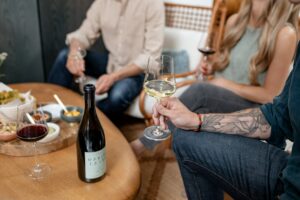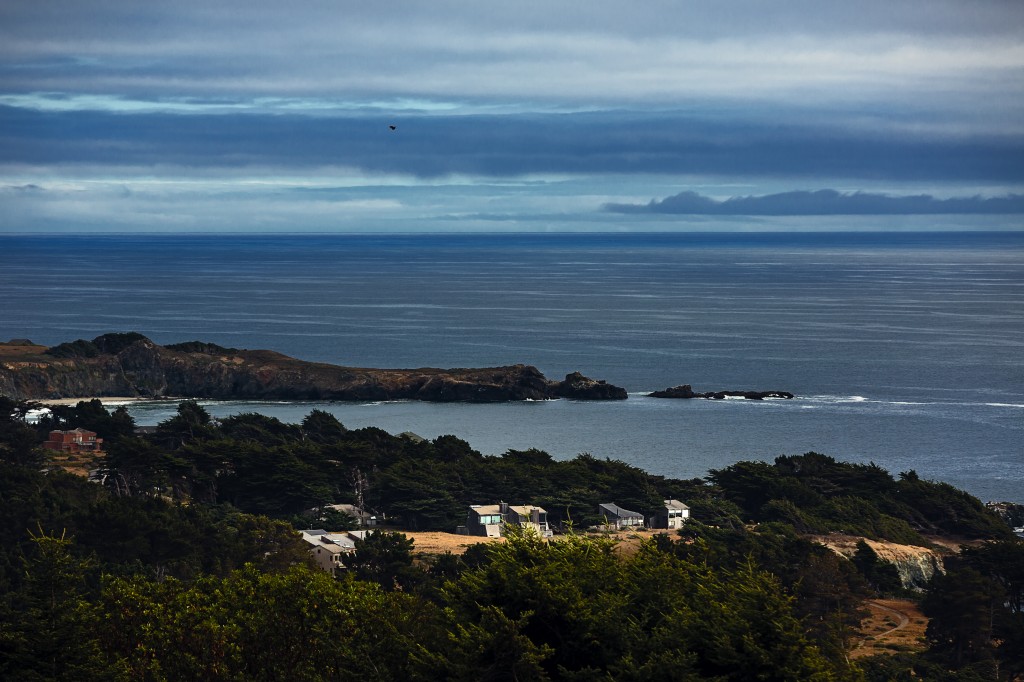
This article was published in the Sept/Oct 2014 issue of Sonoma Magazine.
Al and Diana Edgerton were tooling north to Mendocino for a July 4 getaway in 1964 when they were beckoned off Highway 1 by a “lots for sale” sign bearing a bold ram’s-horn logo.
The sales office had opened just that weekend for an intriguing new development dubbed “The Sea Ranch.” The deals were as seductive as the setting — thick hillside forests of redwood, fir and fern overlooking a tableland of meadows that meet the sea along a shore notched with nubbly cliffs and coves. Lots could be locked up for as little as $4,500 in the forest east of Highway 1, $8,500 in a meadow with at least a peek of the ocean.
“We stopped out of curiosity. We had never heard of The Sea Ranch,” Edgerton, a retired oral surgeon, remembered. “But we cut short our vacation in Elk and put a down payment on a lot.”

It was a radical move for a young couple with one baby and another on the way, who had yet to buy their first home. But that impulsive purchase made them pioneers in a groundbreaking experiment in land development and design that continues to resonate 50 years later.
The Sea Ranch was conceived amid the infant “ecology” movement sparked by Rachel Carson’s 1962 anti-pesticide exposé, “Silent Spring.” Its guiding ethos of “living lightly on the land” was defined by Sea Ranch’s celebrated designer, landscape architect Lawrence Halprin. He would inspire a revolutionary new approach to environmentally sensitive land-use planning and architecture that a half-century later is still studied and admired around the world.
At the same time, pitched battles over public access to The Sea Ranch’s 10 miles of ragged bluffs and beaches made for a tumultuous early history and would have a seismic impact on the future of the entire California coast. Local activists led by Petaluman Bill Kortum, later a county supervisor, spearheaded a fight for public trails into the private enclave. While their efforts failed locally, they took it to statewide voters, culminating in a 1972 ballot initiative creating the powerful California Coastal Commission and in 1976, the state Coastal Act to protect the shoreline and ensure the public can share in its beauty.
The clashes led to hard-won compromises. There are now six public access points to Sea Ranch beaches and a public trail at Black Point. Original plans were slashed from 5,200 to 2,429 lots, of which 1,850 are built. While there are no definitive numbers, Sea Ranch officials figure roughly one-third of the homes are occupied full time, one-third are weekenders and the remainder vacation and long-term rentals.
Without Sea Ranch as a catalyst for California coastal protection, mused former Sonoma County Supervisor Ernie Carpenter, “it would be gruesome out there.”

“We would be fighting access to the tidelands,” he said. “You’d have development along the North Coast in ways that would probably be more like Southern California and you would not have public ownership of the land.”
Eric Koenigshofer, the Sonoma County supervisor representing the coast during some of the angriest debates about a private development that would deny the public access to the coast, makes the same north-south comparison in assessing the lasting effects of Sea Ranch.
“When you think of Orange County and its beach communities, the Sonoma Coast could have developed like that,” he said. “No engineering problem would have prevented something like the Newport Freeway running from Santa Rosa to Bodega Bay.”
Still, Sea Ranch remains the largest development on an otherwise sparsely developed coast, with homes fronting 10 of the 60 miles of Sonoma County coastline. Those coveted 10 miles were part of Rancho Del Mar, a 5,200-acre sheep ranch bought from the Ohlson family for an estimated $2.7 million in 1963.

During the tumultuous years of the debate that followed in the 1970s, disagreements with the new coastal regulators over Sea Ranch’s size and the public’s right to freely access the coast led to legal battles. A virtual moratorium on building sparked what amounted to a Civil War among residents in what was supposed to be a quiet refuge.
And there were casualties. People who had saved and purchased lots on this breathtaking stretch intended to retire there. But they were stalled as the larger political drama played out across the state. While Sea Ranch began a movement that protected the coast for all Californians, sometimes there was individual cost.
“There were a lot of people … in the middle of a public policy dispute,” Koenigshofer said. “They were very likeable people in the late part of their lives who had put everything they had into what they thought was going to be their dream retirement and for many it wasn’t realized.”
To many Sea Ranchers, those times seem lost in the fog. A generation has passed and the community has mellowed into maturity. Disagreements are more “on the squabbling level,” over abalone divers who book vacation rentals and party late, and dust-ups over vegetation — to cut or not to cut, said Jackie Gardner, who heads the elected, seven-member Sea Ranch Association Board of Directors that serves as an unofficial town council.
Even the early schism between The Sea Ranch and working-class Gualala residents, who regarded the newcomers as elitist SOBs (South of the Bridgers, meaning the Gualala Bridge) seems to have largely receded like the tide.
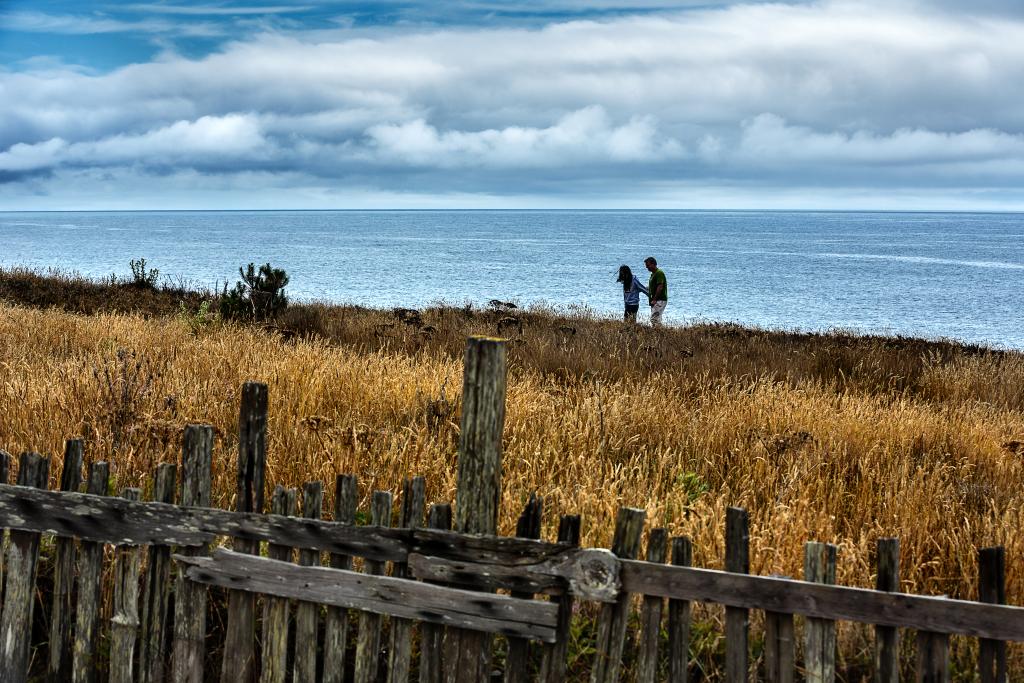
“One of the things about The Sea Ranch is that although you have retired CEOs and very intelligent people who come up here, if they bring an attitude, they don’t make it,” Walt Jorgenson said. The burly real estate agent lived many years in Sea Ranch and boasts that his daughter is a true native, born on a dark and stormy night in his mother-in-law’s Sea Ranch home. Now he lives in Gualala, but after 30 years selling and renting homes in Sea Ranch, Jorgenson is intimate with its ways.
Joel Crockett, who owns Four-Eyed Frog Books in Gualala and has lived in both communities, said Gualala, where Sea Ranchers go for all their services, probably “wouldn’t exist in the form it exists if The Sea Ranch didn’t exist.”
Fifty years after purchasing one of the first Sea Ranch lots, the Edgertons still make the stomach-turning 2 1/2-hour drive from the East Bay to their seaside refuge. Theirs is one of the quintessential early Sea Ranch homes, a so-called “Binker Barn,” designed by William Turnbull, one of the first architects of the development. “We never envisioned ourselves staying there that long,“ Al Edgerton said. “I envisioned it getting too crowded and we’d move on somewhere else. But we haven’t.”

That loyalty is testament to the ideals of The Sea Ranch founders and architects, such as Donlyn Lyndon and Dick Whitaker, who still maintain weekend homes there, as well as other watchdogs inside and outside the community. With some exceptions, such as the occasional too-big home, their combined efforts have largely ensured that it would not be overbuilt or visually upstage the hillside forests to the east, open meadows teeming with wildlife and the moody surf beyond.
Not every early observer embraced the simple, unpainted and unadorned wood dwellings that from a distance might have appeared undistinctive. But that radical-for-the-time simplicity was deliberate.
“We didn’t set out to be master architects, but to be thinking in ways that had to do with the whole,” said Lyndon, who was a 27-year-old instructor at UC Berkeley when his design firm MLTW (Moore Lyndon Turnbull Whitaker) was tapped to draw up plans for the first condominium complex at Sea Ranch in 1963. Inspired by the weathered barns still dotting the land, the timber-framed “Condominium One” is now regarded as one of the most notable examples of 1960s architecture and is on the National Register of Historic Places.
“We expected it would be a community, not in the sense of streets with porches, but a community within a natural setting which was dominant,” Lyndon explained, while seated on a deck overlooking a large boulder set in the meadow. He said the rock is what sold him and his artist wife, Alice Wingwall, on this lot over all others — far more than the sea in the distance. “And it would be a community of people who cared about that, who wanted to bike and be near the ocean and wanted to experience the birds and the wildlife. That would be what bonded them together.”
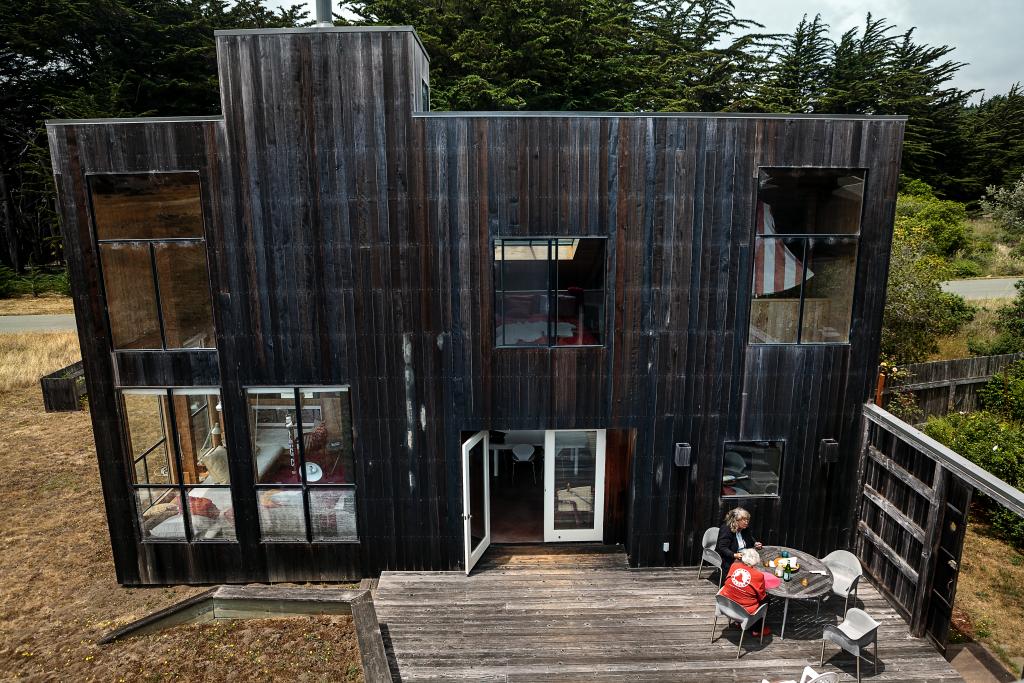
The Sea Ranch is in the midst of a yearlong celebration of its first 50 years, marked by months of special events, talks and forums. It culminates May 23-24, 2015, with the premiere of an original musical piece inspired by The Sea Ranch and performed by the Kronos Quartet in the old “white barn.”
Over time, the community has seasoned from an early population of artsy bohemians and intellectuals into a graying community of educated, accomplished and affluent people, both retirees and weekenders (the median age is nearly 64) who traded urban excitement for quiet isolation and a lifestyle based on the outdoors and volunteerism. Residents have ranged from the late Nobel Prize-winning economist Milton Friedman to renowned psychologist and writer Philip Zimbardo, to CBS News correspondent Barry Petersen.
It is a tightly controlled isolation governed by rigid guidelines aimed at protecting the integrity of the community. It’s not for a rugged individualist. Every detail is managed, from the shade of the stain on your wood siding to the plants you can put in your personal landscape, all of which must be native not just to California, but to your zone on the ranch. Rules are so well-enforced by the powerful Design Committee, the elected Sea Ranch Association Board, the ranch’s security patrol and fellow residents, that decades later The Sea Ranch still evokes its farming roots. The original white Knipp-Stengel barn was restored into a meeting place and sheep trim the meadows crossed by 100-year-old cypress hedgerows running to the sea.
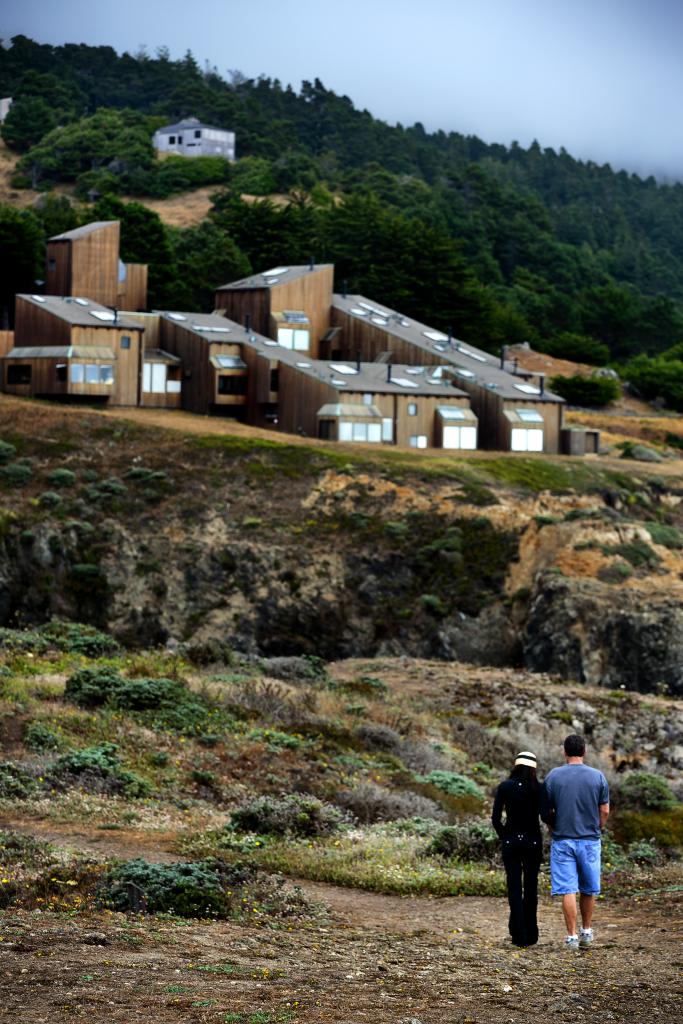 “People who choose to live there are true believers,” said George Homsey, 89, who worked with the late Joe Esherick to design the first “Hedgerow Houses” at Black Point, with their sloping roofs of various pitches for wind protection. They set the standard for the Sea Ranch look.
“People who choose to live there are true believers,” said George Homsey, 89, who worked with the late Joe Esherick to design the first “Hedgerow Houses” at Black Point, with their sloping roofs of various pitches for wind protection. They set the standard for the Sea Ranch look.
Andrea Lunsford looks out her broad picture window toward the churning waves. In the foreground, hikers amble the same public trail that brought her to this exact spot from nearby Gualala Point Regional Park. She didn’t even know she’d entered a place called Sea Ranch then, but she saw a “for sale” sign and made a down payment that very day.
An elegant woman of 71, she welcomes people to share the views from land she is only “shepherding for a while.” When Lunsford first built her house, the Stanford emeritus professor and nationally recognized scholar on writing and rhetoric conceded she felt “constrained by the rules.” The pink plastic flamingos her friends put in front of her house in welcome led to a quick rebuke.
But she said she’s come to embrace Sea Ranch’s utopian ideal of putting the common good ahead of self-interest.
“To me, this place is about peace and calm and connection to the natural world,” said Lunsford, who still travels frequently but comes to Sea Ranch as much as possible to unwind and write from a loft with ocean views that gives her the feeling of being aboard a ship. “When I’m driving up and get to Bodega Bay and see what I think of as my ocean opening out, it’s like a physical difference comes over me. Everything lowers to a calm resting place and by the time I get here I feel so happy.”
To outsiders who need more action, life at Sea Ranch might appear lonely, even dull. There are no streetlights to wash out the starry skies and the chill coastal winds are fierce, so roads empty at dusk. Residents say it belies a vibrant social life both outdoors in the daytime and at night indoors, where it’s all about sharing convivial meals with friends who all seem to have an interesting story.
“Food seems very much a part of being here and we plan our days around it — and beautiful walks on the bluff,” said Gabriel Ramirez, a radiologist who splits his time between Los Angeles and a home office in a dramatic house of concrete and weathered Corten steel that represents a new wave of Sea Ranch design.
The clustered housing, designed to protect open areas shared by all and inspired by Halprin, leads to some disagreements over vegetation blocking views. But it also fosters neighborliness.

There are weekly summer potlucks at “The Hot Spot,” a warm pocket by the Gualala River; an annual pancake breakfast; a 110-member communal garden dubbed the Posh Squash run with corporate efficiency; an active trails committee; and a docent program to monitor seals during the pupping season.
“We have an active trails committee and nature walks almost every Saturday. We have the California Coastal National Monument that monitors seabirds and endangered grasses. There’s an extraordinary amount of things to do,” said Jackie Gardner, who lives in a modest house in the hillside forest with views that would cost so much more in Carmel.
By its very design and remote location, Sea Ranch remains a self-selected community of people who consciously choose the lifestyle. There’s no easy way to get there. Internet and cell service remain sketchy, although some residents think a new fiber optic network in the works might inspire an infusion of younger telecommuters. With only one medical clinic in Gualala, most residents subscribe to two emergency helicopter services.
Carolyn André, an advertising and marketing consultant for international companies, said her husband, Barry Richman, suffered an aneurysm, was airlifted to Santa Rosa and survived.

The couple lived for years in Berkeley, where they had season tickets to the ballet and opera. Now they get their cultural infusion at the Gualala Arts Center. They catch recorded Metropolitan Opera performances and British plays at the old Arena Theater, a half-hour drive north.
“It may not be in the flesh, but they are spectacular events,” André said with a laugh. “And you get to go in your blue jeans with your brown-bag lunch.”
Add the cliff-hugging 30-mile trip north from Jenner, and you weed out anyone who is isn’t comfortable blending inconspicuously into the landscape in the same way as the architecture.
“This whole area is quite an egalitarian place,” said Mary Alinder, a longtime Sea Ranch resident and Gualala gallery owner who was an executive assistant to the renowned photographer Ansel Adams and co-authored his autobiography. “It’s not a place for flashy clothes or high heels or jewelry. If you’re into shopping, this is not the place. If you like nightlife, this is not the place. I truly believe if you start talking to any individual here you will find someone who has contributed to this Earth in some wonderful way. People who choose to live here have a lot in common and often they like being removed from the urban areas.”
Sea Ranchers don’t pretend they live in a utopia.

Lisa Dundee, an architect who heads up the all-powerful committee that controls every detail of Sea Ranch design, laments the increase in property values pushed, in part, by an influx of people in the 1990s who didn’t understand the rules were a common sacrifice for a different kind of reward. Recent listings for lots at The Sea Ranch ranged from $25,000 for the forest up to $795,000 for an ocean view. House prices range from $299,000 for a 40-year-old, 567-square-foot forest cabin to $3.8 million for a luxury estate on 4 oceanfront acres.
“After you’ve lived up here awhile you recognize the greater good and find a way to accommodate to it rather than expect your environment to accommodate to you.”
Residents speak of the peace they find at The Sea Ranch and the thrill of watching nature at play, a legacy of the original vision that remains, having withstood the battering of economic, political and environmental forces over more than half a century.
In the end, André said, the magic of the place comes back to the one natural wonder that can never be replicated and that all of California feared losing when the development was begun so long ago: “I do think it’s the ocean — the smell, the sound, the movement, even the colors, the light glinting off it.”
****
1846: Ernest Rufus receives 17,580-acre Mexican land grant from Gualala River to Ocean Cove and sends Frederick Hugal to make improvements to what becomes “Rancho de Hermann.”
1860: After changing hands several times, the land is turned over to Chris Stengel and Adam Knipp, who raise cattle and log timber, shipping from what they call Walhhala Ranch, or Gualala.
1904: William and George Bender buy the 5,200-acre Knipp Stengel Ranch and create the Rancho del Mar settlement that would eventually become The Sea Ranch.
1910: Their Del Mar Mill burns, residents disperse, and the land is eventually purchased by Walter P. Frick. He raises sheep and plants cypress hedgerows.
1941: The Ohlson family of Annapolis buys Del Mar Ranch at auction after Frick dies and the land is seized for back taxes.
1963: Oceanic Properties, a subsidiary of Hawaiian developers Castle & Cooke, pays an estimated $2.7 million for the Ohlson ranch with plans to develop a “high quality second home colony.” Landscape architect Lawrence Halprin is hired to design a plan that would minimally disrupt the natural landscape.
1964: Sonoma County OKs plans for the southern edge of Sea Ranch. Ground is broken on three demonstration projects designed by a team of young Bay Area architects.
1965: The guiding principles of The Sea Ranch, contained in 111 pages of rules, are filed May 10, considered by many the official “birthday” of the development.
1966: The design world begins to recognize Sea Ranch with the first of many awards, including The Governor’s Design Award for planned communities. Controversy stirs over public access to Sea Ranch beaches.
1968: Petaluma veterinarian Bill Kortum leads citizens’ fight for public access to Sea Ranch. Measure B, which would have required new coastal development in Sonoma County to provide public-access corridors, is defeated.
1972: Coast Alliance takes the case to statewide voters who approve Proposition 20, setting up the California Coastal Commission to oversee coastal development and ensure public access.
1973: The Coastal Commission, concerned about population projections of 15,000 people at buildout in The Sea Ranch and access issues, begins denying permits, leading to a virtual building moratorium. A protracted legal fight begins between the state and regional commissions and The Sea Ranch Association. Many lot owners are in limbo and the community divides deeply.
1980s: The Bane Bill is approved by the Legislature, settling the fight. Coastal authorities win on most points, including requiring five public-access trails from the highway to the beach, but relinquish permitting powers over The Sea Ranch. A financially battered Oceanic focuses on premium lots and development of the north end in a way many felt was less in the spirit of Halprin’s original design.
2014: Plans are announced for a yearlong 50th birthday celebration of The Sea Ranch.
****
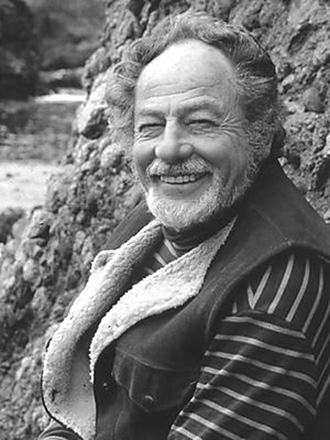 Lawrence Halprin: A Man With Vision
Lawrence Halprin: A Man With Vision
Lawrence Halprin, designer of The Sea Ranch, envisioned a community of rustic homes, set in the land in a way that would protect the views and clustered around open meadows where the natural flora is scrupulously preserved.
He camped at Sea Ranch while working on his plans for 10 miles of coastal meadows and forests, observing wind and weather patterns, soil and vegetation, and the contours of the land. He noted shadows, tidal changes, cormorant nests, kelp beds and seal colonies, all to incorporate development rather than carve it out of the landscape.
Halprin characterized The Sea Ranch challenge as “a wonderful experiment in ecological planning … a place where nature and human habitation could intersect in the kind of intense symbiosis that would allow people to become part of the ecosystem.”
His unconventional plans, illustrated with freehand drawings, included condominiums — a new housing concept that raised eyebrows at the time. His intent was to leave as small a footprint as possible, protect open spaces for walking and recreation, and to not wall off “the constant presence of the Pacific views.” Roads had no curbs or sidewalks. He planted more than 100,000 trees.
Halprin, whose other design triumphs include Ghirardelli Square in San Francisco, Sproul Plaza in Berkeley, the pedestrian approach to Yosemite Falls and the Franklin Roosevelt Memorial in Washington, D.C., left The Sea Ranch project in the late 1960s yet maintained a home there, returning often before his death in 2009.
****
The Sea Ranch at 50: Celebrating an Idea
The Sea Ranch celebrates its 50th birthday through May 2015 with multiple events. The following are open to the public; visit tsra.org for details:
Oct. 5
Celebrate Our Coast on the Screen: The Stewardship Task Force for the California Coastal National Monument presents a slide show of the Sonoma-Mendocino coast and its wildlife. 2:30 p.m., Del Mar Center Hall, The Sea Ranch
Oct. 18
The Once and Future Sea Ranch: An Architectural Forum: An all-day public forum that will encourage outside critique and discussion of The Sea Ranch and its future. Donlyn Lyndon, a founding architect, will provide historical perspective. 10 a.m. to 5 p.m., Knipp-Stengel (White) Barn, The Sea Ranch.
Dec. 6
Sea Ranch Mysteries: Little-Known Events & Sites: Harry Lindstrom tells the behind-the-scenes stories of the region, pre-The Sea Ranch. Noon, Del Mar Center Hall
March 17, 2015
Life in the Pre-Sea Ranch Communities: Black Point, Del Mar and the Russians’ first farm are explored in this presentation on life before The Sea Ranch. A short escorted walk to several Del Mar area sites follows. 10 a.m., Del Mar Center Hall
May 9, 2015
Soroptimist 31 Annual Architectural Tour, Wine Tasting & Auction: The tour includes eight iconic Sea Ranch homes. The event continues with a wine tasting and silent auction at Gualala Arts in Gualala. Proceeds support local community projects. 10 a.m, to 9 p.m.
May 23-24, 2015
Kronos Quartet World Premiere and Sea Ranch Volunteer Fire Department Barbecue: Memorial Day weekend features a May 24 barbecue to benefit the Sea Ranch Volunteer Fire Department and two world-premiere concerts by the Kronos Quartet (May 23 and 24) of an original piece written by Serbian composer Aleksandra Vrebalov, as an homage to The Sea Ranch. The concerts, at the Knipp-Stengel Barn, are free.





